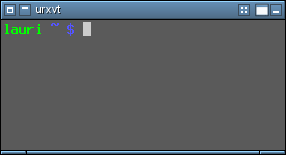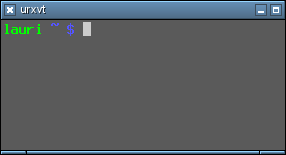Help:Configuration
From Openbox
Openbox configuration is made essentially by modifying just one file called rc.xml. Default configuration file can by default be found in /etc/xdg/openbox/ and a user specific file can be placed in ~/.config/openbox/. By default there is also menu.xml which is for menu configuration. Menu configuration is separated from rest of the configs. rc.xml is separated into different sections. All the options are discussed below with examples.
Contents |
Resistance
<resistance> <strength>10</strength> <screen_edge_strength>20</screen_edge_strength> </resistance>
strength Tells Openbox how much resistance (in pixels) there is between two windows before it lets them overlap.
screen_edge_strength Basically the same as strength but between window and the screen edge.
Focus
<focus> <focusNew>yes</focusNew> <focusLast>yes</focusLast> <followMouse>no</followMouse> <focusDelay>200</focusDelay> <underMouse>no</underMouse> <raiseOnFocus>no</raiseOnFocus> </focus>
focusNew Openbox will automatically give focus to new windows when they are created, otherwise the focus will stay as it is.
followMouse Makes focus follow mouse. e.g. when the mouse is being moved the focus will be given to window under the mouse cursor.
focusLast When switching desktops, focus the last focused window on that desktop again, regardless of where the mouse is. Only applies followMouse is set.
focusDelay The time (in milliseconds) Openbox will wait before giving focus to the window under mouse cursor. Only applies if followMouse is set.
underMouse Focus windows under the mouse not only when the mouse moves, but also when it enters another window due to other reasons (e.g. the window the mouse was in moved/closed/iconified etc). Only applies if followMouse is set.
raiseOnFocus Also raises windows to top when they are focused. Only applies if followMouse is set.
Placement
<placement> <policy>Smart</policy> <center>no</center> </placement>
policy can be either Smart or UnderMouse.
- Smart will cause new windows to be placed automatically by Openbox.
- UnderMouse makes new windows to be placed under the mouse cursor.
center can be either yes or no. If it is enabled, windows will open centered in the free area found.
Theme
<theme>
<name>Clearlooks</name>
<titleLayout>NLIMC</titleLayout>
<keepBorder>yes</keepBorder>
<animateIconify>yes</animateIconify>
<font place="ActiveWindow">
<name>sans</name>
<size>8</size>
<weight>bold</weight>
<slant>normal</slant>
</font>
<font place="InactiveWindow">
<name>sans</name>
<size>8</size>
<weight>bold</weight>
<slant>normal</slant>
</font>
<font place="MenuHeader">
<name>sans</name>
<size>9</size>
<weight>normal</weight>
<slant>normal</slant>
</font>
<font place="MenuItem">
<name>sans</name>
<size>9</size>
<weight>normal</weight>
<slant>normal</slant>
</font>
<font place="OnScreenDisplay">
<name>sans</name>
<size>9</size>
<weight>bold</weight>
<slant>normal</slant>
</font>
</theme>
name The name of the Openbox theme to use.


- N :window icon
- L :window label (aka. title)
- I: iconify
- M: maximize
- C: close
- S: shade (roll up/down)
- D: omnipresent (on all desktops).
keepBorder tells if windows should keep the border drawn by Openbox when window decorations are turned off.
animateIconify adds a little iconification animation if enabled.
font Specifies the font to use for a specific element of the window. Place can be either of
- ActiveWindow: Title bar of the active window
- InactiveWindow: Title bar of the inactive window
- MenuHeader: Titles in the menu
- MenuItem: Items in the menu
- OnScreenDisplay: Text in popups such as window cycling or desktop switching popups
Childnodes for each place are name, specifying the font to use (defaults to sans, an alias for all sans serif fonts), size in px, weight, either normal or bold and slant, either italic or normal.
Themes themselves are described on the theme specification page.
Desktops
<desktops>
<number>4</number>
<firstdesk>1</firstdesk>
<popupTime>1000</popupTime>
<names>
<name>work</name>
<name>play</name>
<name>dull</name>
<name>boy</name>
</names>
</desktops>
number The number of virtual desktops to use.
firstdesk The number of the desktop to use when first started.
popupTime Time (in milliseconds) to show the popup when switching desktops. Can be set to 0 to disable the popup completely.
names Each name tag names your desktops, in ascending order. Unnamed desktops will be named automatically depending on the locale. You can name more desktops than specified in number if you want.
Resize (and move)
<resize>
<drawContents>no</drawContents>
<popupShow>Always</popupShow>
<popupPosition>Fixed</popupPosition>
<popupFixedposition>
<x>400</x>
<y>center</y>
</popupFixedPosition>
</resize>
drawContents Resize the program inside the window while resizing. When disabled the unused space will be filled with a uniform color during a resize.
popupShow When to show the move/resize popup. Always always shows it, Never never shows it, Nonpixel shows it only when resizing windows that have specified they are resized in increments larger than one pixel, usually terminals.
popupPosition Where to show the popup.
- Top shows the popup above the titlebar of the window.
- Center shows it centered on the window.
- Fixed shows it in a fixed location on the screen specified by popupFixedPosition.
popupFixedPosition Specifies where on the screen to show the position when Fixed. Both x and y take coordinates as described here.
Applications
This section sets specific settings for applications, and is quite complicated, so it has its own page.
Keyboard
<keyboard>
<rebindOnMappingNotify>yes</rebindOnMappingNotify>
<chainQuitKey>C-g</chainQuitKey>
<keybind ...
...
</keybind>
</keyboard>
rebindOnMappingNotify If this is enabled, keybinds will be rebound if the keyboard layout changes at runtime. It is enabled by default.
The rest of this section contains keyboard shortcuts and is described on the bindings page.
Mouse
<mouse>
<dragThreshold>8</dragThreshold>
<doubleClickTime>200</doubleClickTime>
<screenEdgeWarpTime>400</screenEdgeWarpTime>
<context ...
...
</context>
</mouse>
dragThreshold How many pixels you need to drag for it to be recognized as a drag operation.
doubleClickTime Time (in milliseconds) allowed between two separate clicks to register as a DoubleClick.
screenEdgeWarpTime Time (in milliseconds) to pause between two consecutive desktop switches done by holding the cursor next to the screen edge. Set to 0 to disable this feature.
The rest of this section contains mouse bindings and is described on the bindings page.
Margins
<margins> <top>50</top> <left>0</left> <right>20</right> <bottom>0</bottom> </margins>
Each tag specifies the amount of pixels to reserve at the respective edge of the screen. New windows will not be placed in those areas, and maximized windows will not cover them.
Menu
<menu> <hideDelay>250</hideDelay> <middle>no</middle> <submenuShowDelay>100</submenuShowDelay> <submenuHideDelay>400</submenuHideDelay> <applicationIcons>yes</applicationIcons> <manageDesktops>yes</manageDesktops> <file>menu.xml</file> </menu>
hideDelay How long (in milliseconds) you have to hold the mouse button down for it to be hidden automatically when you release it. If you hold shorter, it will stay up when you release.
middle Position menus centered vertically instead of aligned to the top.
submenuShowDelay and submenuHideDelay affect how submenus pop up when moving across them. When moving away from a submenu it is closed after submenuHideDelay, and when moving into one, it is opened after submenuShowDelay. When moving from one submenu to another, the hide delay is only used if it is lower than the show delay (e.g. by default it is not used). The old submenu is closed after HideDelay milliseconds, and after ShowDelay milliseconds (after moving) the new one is shown (and the old one is hidden even if HideDelay has not expired yet).
applicationIcons Whether to show window icons in the Desktop and Windows menus (client-list-menu and client-list-combined-menu).
manageDesktops Whether to show the Add new desktop and Remove last desktop entries in the Desktop and Windows menus.
file Specify files to load menu specifications from. Can be given more than once, although care should be taken to avoid id clashes. Files are searched for in the user directory first and then in the system directory.
Dock
<dock> <position>TopLeft</position> <stacking>Normal</stacking> <direction>Vertical</direction> <floatingX>0</floatingX> <floatingY>0</floatingY> <autoHide>no</autoHide> <hideDelay>300</hideDelay> <showDelay>300</showDelay> <moveButton>Button8</moveButton> <noStrut>yes</noStrut> </dock>
The dock is only shown when one or more dockapps are running.
position Specify where to show the dock. Can be one of TopLeft, Top, TopRight, Right, BottomRight, Bottom, BottomLeft, Left and Floating.
stacking Which window layer to put the dock in. Can be one of above, normal, below. The dock can be raised and lowered by left and middle clicking on it, among windows in the specified layer.
direction Specify if dockapps should be laid out in a Vertical or Horizontal direction.
floatingX and floatingY When position is set to Floating, these specify the pixel position of the dock. Cannot currently use the slightly extended format described at the bottom of this page.
autoHide Whether to hide the dock automatically when the mouse is not over it.
hideDelay and showDelay specify (in milleseconds) the delays for hiding and showing the dock when the mouse leaves and enters it, respectively.
moveButton Specifies which button to use for moving individual dockapps around in the dock, see the bindings page for details.
noStrut Specifies that the dock should not set a strut, which means it won't stop windows from being placed or maximized over it. When position is set to Floating, this is always on, since openbox doesn't guess which edge it should belong to based on just the position. You can use margins to emulate that if you want.
Coordinates
Many places in openbox that take a coordinate supports a slightly extended format. Most simply it can be just a number such as 300. Such a coordinate will be left- or top-aligned depending on which coordinate it is. To align to the opposite edge, use -300. To specify a negative offset, a - is also used, so you have to use +-10 to offset 10 pixels negatively to the left/top and --10 for the right/bottom edge. Some things enforce being onscreen though, such as the move/resize popup.